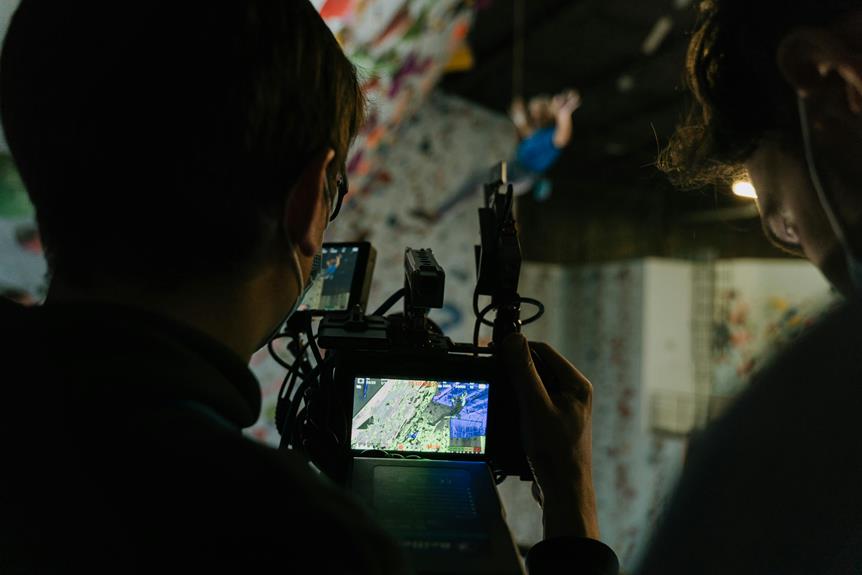When comparing the Nikon D300 camera, you'll find exceptional image quality, robust build, and competitive pricing. It's a versatile choice for photography enthusiasts seeking reliable performance, customizable settings, and affordability. The autofocus system impresses with speed and tracking accuracy, though it struggles in low light. The camera excels in low light situations with vibrant colors, sharp details, and excellent dynamic range. Battery life, while commendable, may fall short in high-demand scenarios. Ergonomics receive praise for a comfortable grip and efficient button layout. Considering individual needs and the balance of pros and cons can guide your decision on this reliable camera.
In a Nutshell
- The Nikon D300 offers excellent image quality and impressive speed, outperforming many cameras in its class.
- Its robust build and durability make it a reliable choice for long-term use, withstanding tough conditions.
- However, the autofocus system on the D300 may fall short in terms of accuracy and speed compared to newer models on the market.
- While the camera lacks some of the latest features and technological advancements, it still provides a good balance of performance and affordability.
- Despite being considered outdated, the Nikon D300 remains a solid option for photographers looking for a reliable camera without breaking the bank.
Specifications & Performance
When considering the specifications and performance of the Nikon D300 camera, you'll be impressed by its exceptional image quality and speed. The low light performance of the D300 is remarkable, allowing you to capture clear and detailed shots even in challenging lighting conditions. Its robustness guarantees that this camera can withstand the rigors of regular use.
On the downside, some users have reported issues with the auto-focus accuracy in certain situations, which can be frustrating. Furthermore, while the D300 offers excellent video capabilities, it may not have the latest features found in newer camera models. Despite these drawbacks, the D300 still provides wide lens compatibility for versatile shooting options.
Camera's Autofocus System
The Nikon D300's autofocus system has its strengths and weaknesses that impact the overall performance of the camera:
- Positive: The D300's autofocus system is impressively fast, allowing you to quickly capture sharp images in various shooting conditions.
- Positive: It offers accurate tracking, ensuring that moving subjects are kept in focus, making it ideal for action shots.
- Positive: Improved autofocus algorithms contribute to enhanced precision, resulting in better overall image quality.
- Negative: At times, the autofocus system may struggle in low light situations, leading to slower focusing speeds and potential hunting.
- Negative: While the system adapts well to different scenes, it may occasionally struggle to lock focus on small or distant subjects.
- Positive: Despite its occasional shortcomings, the D300's autofocus performance is generally reliable, providing consistent results for your photography needs.
Image Quality Strengths
The Nikon D300 camera offers a mix of image quality strengths and weaknesses that you should consider:
- Low light performance: The camera excels in capturing clear and detailed images even in poorly lit environments, ensuring quality shots in challenging lighting conditions.
- Vibrant color reproduction: It delivers precise and vivid colors, enhancing the realism of your photographs and bringing your subjects to life.
- Sharpness: Images produced by the Nikon D300 are crisp and well-defined, showcasing intricate details with clarity.
- Dynamic range: The camera effectively balances highlights and shadows, resulting in well-exposed photos with good tonal range.
- Color accuracy: Colors are rendered accurately, ensuring that your images reflect true-to-life colors for a more authentic look.
However, it's important to note that the Nikon D300 may have some limitations:
- Noise in high ISO settings: At higher ISO settings, the camera may introduce noticeable noise in images, affecting overall image quality.
- Limited resolution: Compared to newer camera models, the D300's resolution may be lower, which could impact the level of detail in your photos.
- Slower autofocus in low light: The autofocus performance of the camera may be slower in low light conditions, potentially leading to missed focus or slower shooting speeds.
Battery Life Comparison
When comparing the battery life of the Nikon D300 camera to its counterparts, there are notable differences in longevity and performance.
Positive Points:
Claim Upto 81% Off On Bestseller Home Decor Products
- The Nikon D300 boasts commendable battery longevity, allowing for extended shooting sessions without frequent recharging.
- Users appreciate the various charging options available for added convenience, ensuring the camera remains powered up when needed.
- The camera showcases excellent power management capabilities, effectively utilizing energy for efficient performance.
- Its energy efficiency is a standout feature, contributing to prolonged battery life and reducing the need for frequent recharges.
- The balance between power consumption and performance is well-received by users, providing a reliable shooting experience.
Negative Points:
- Some users may find the battery life of the Nikon D300 to be slightly shorter compared to newer camera models with more advanced power-saving features.
- In certain high-demand shooting scenarios, the battery performance of the Nikon D300 may fall short, requiring extra precautions or backup batteries for extended use.
Camera's Ergonomics Evaluation
When evaluating the Nikon D300's ergonomics, consider the grip comfort level, button layout efficiency, and weight distribution balance.
These three points play an important role in how comfortable and intuitive the camera feels in your hands.
Examining these aspects will help you determine if the camera is well-designed for your shooting needs.
Grip Comfort Level
The Nikon D300 camera offers a comfortable grip that enhances the overall user experience. The design minimizes hand fatigue, allowing for extended shooting sessions without discomfort.
However, some users may find the grip slightly bulky, which could be a drawback for those with smaller hands. Despite this, the camera fits snugly in your hand and is easy to maneuver, providing stability and control for capturing perfect shots.
Button Layout Efficiency
The button layout of the Nikon D300 is designed for efficient operation, with intuitive placement allowing for quick access to key functions. The customizable options cater to various user preferences, enhancing the camera's usability.
However, some users may find the button layout slightly crowded, leading to accidental presses. Despite this, the ease of managing settings and controls on the D300 makes it a convenient choice for photographers seeking efficiency in their workflow.
Weight Distribution Balance
When it comes to holding the Nikon D300, the weight distribution balance plays a crucial role in both comfort and stability. On the positive side, the camera is designed to provide a comfortable grip, ensuring that users can hold it securely without experiencing fatigue even during long shooting sessions. Additionally, the weight is evenly distributed across the body, making it convenient to carry around for photography outings.
However, on the downside, some users may find the weight distribution to be slightly imbalanced, leading to potential strain on the wrist or arm after prolonged use. While the camera aims for portability, the weight distribution may not suit everyone's preferences, especially for those looking for a lighter option. Despite these drawbacks, the thoughtful consideration given to weight distribution enhances the overall user experience, enabling smoother operation and reduced discomfort for most photographers.
User Satisfaction Levels
Users have expressed high praise for the Nikon D300 camera, citing its exceptional performance and reliability as standout features. Many users appreciate the seamless user experience offered by the camera, with its advanced features and user-friendly interface receiving positive feedback.
However, some users have noted that the camera's weight and size may be a drawback for those looking for a more compact option. Despite this, the D300's reliable build quality and impressive image quality have left many users impressed, making it a top choice for photographers seeking a dependable and high-performing camera for their creative endeavors.
Value for Money?
When evaluating the Nikon D300 camera in terms of value for money, there are both positive and negative aspects to consider.
On the positive side, the D300 offers a range of advanced features and capabilities that are typically found in higher-end cameras, making it a great option for enthusiasts and professionals alike. The camera has a robust build quality, excellent image quality, and a wide array of customizable settings to tailor the shooting experience to your preferences. Additionally, the D300 is competitively priced, providing a good balance between performance and affordability.
However, on the negative side, some users may find the D300 to be a bit outdated in terms of technology and features compared to newer camera models on the market. This could potentially impact its long-term value and relevance as newer advancements are introduced. Additionally, the D300's autofocus system may not be as fast or accurate as some of its more recent counterparts, which could be a drawback for photographers who rely heavily on quick and precise focusing.
Final Verdict: Pros and Cons
In assessing the Nikon D300's overall value proposition, it's crucial to consider the pros and cons of the camera.
On the positive side, it delivers exceptional image quality and boasts a robust build that appeals to both professionals and enthusiasts.
However, its bulky design and use of older technology may be off-putting to users looking for a more compact or up-to-date model.
Despite these drawbacks, users generally report high satisfaction with the camera's performance.
It's important to weigh these factors against individual needs and preferences when deciding whether the Nikon D300 is the right choice.
Frequently Asked Questions
What Are Some Popular Accessories That Can Enhance the Performance of the Nikon D300 Camera?
Enhance your Nikon D300 camera with popular accessories. Lens filters improve image quality, tripods stabilize shots. Camera straps offer comfort, external flash adds light. Elevate your photography game with these tools for better performance and creativity.
How Does the Nikon D300 Compare to Other Cameras in Its Price Range in Terms of Durability and Weather Resistance?
When it comes to durability comparison, the Nikon D300 stands out in its price range. Its robust build can handle rough conditions. The weather resistance evaluation is impressive, making it a reliable choice for outdoor photography adventures.
Can the Nikon D300 Be Used for Professional Videography, or Is It Primarily a Still Photography Camera?
You'll find the Nikon D300 great for professional videography with its excellent camera capabilities. It excels in capturing high-quality videos, making it a versatile tool for your creative projects. Enjoy its performance!
Are There Any Known Common Issues or Technical Glitches That Users Should Be Aware of When Using the Nikon D300?
When utilizing the Nikon D300, you may come across some common issues or technical glitches. Maintain smooth operation by staying updated on firmware releases, and troubleshoot any problems promptly to keep capturing amazing shots.
How Does the Customer Service and Support From Nikon Compare to Other Camera Brands for the D300 Model?
When it comes to customer service and support, Nikon excels in fostering customer satisfaction and brand loyalty. Their prompt responses and knowledgeable staff make you feel valued, setting them apart from other camera brands.


